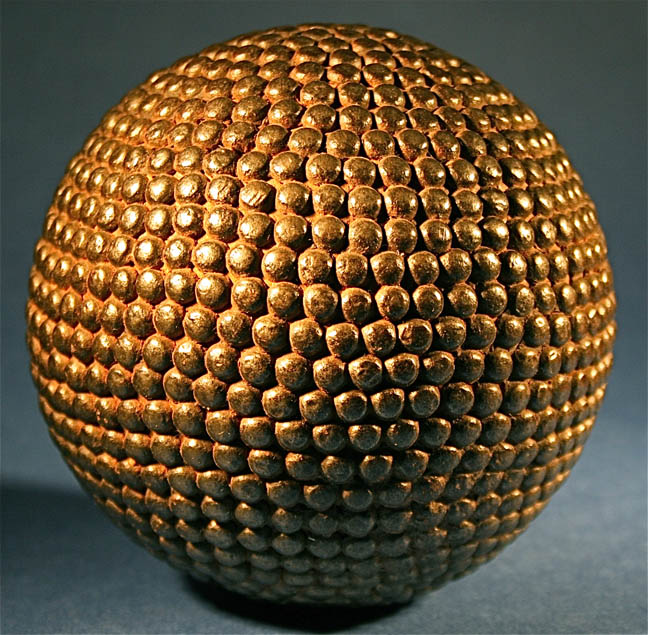

Title: Antique Steel Nails Throwing Sand Bocce Volo Ball Game
Shipping: $29.00
Artist: N/A
Period: 19th Century
History: N/A
Origin: Southern Europe > Italy
Condition: Very Good
Item Date: 1872 to 1920
Item ID: 4680
This is a great example of a old design of a Bocce or Volo ball. A lovingly example. What beautiful objects, with such a rich history! It makes you wonder what will happen to this sport over the next few years as the few, older people still playing the game trundle off to aviaries in the sky. Maybe it is time to take up a new, gentle on the joints, sport as we creep into our own old age? The word “bocce” is a plural of the word “boccia” meaning ball in Italian. "Volo," as it is also called by the Italians, derives it’s name from the Italian verb “volare,” meaning “to fly” and refers to the manner of throwing a ball through the air in the attempt of striking away an opponents ball. The French refer to the sport as "Boule Lyonnaise." Many believe the ancient Phoenicians, Egyptians, Greeks, & Romans invented an early form of bocce. One theory suggests their soldiers played with rocks to pass time in-between battles. Modern Bocce finds its origins near the cities of Torino, Italy and Lyon, France and stems from the House of Savoy dynasty, which ruled from 1003 to 1860. Until the middle of the 19th century players used plain wooden balls made of boxwood, beech or elm. Sometimes their owners would "fortify" them by adding a few blacksmiths' nails here and there. These wooden balls had many defects; they wore out and deformed quickly, especially if the game was played on a hard and rocky ground. After 1872 factory made nails became available and, applied to ball-making, the results were made for durable balls covered in iron nails with large round heads; and later flathead nails. These balls were larger and heavier (from 100 to 150 mm and up to 1500 g). The makers became real artists using nails of different metals (steel, brass and copper) to set out different designs: symbols, numbers and letters, but also stars, flowers and hearts according to the wants of the players. In 1923 metal technology took hold and players since use custom-made bronze balls with variations in weight (900 - 1200g), diameter (90 - 110mm), and pattern, so they can use a ball most suitable for their hand size and throwing style. These balls can be hollow; or filled with an array of non-liquid substances to minimize bouncing. The first club of Bocce was born in 1850 in Lyon, France and called "Le Clos Jouve" on the "plateau de la Croix-Rousse." The first major competition was The Pentecote tournament Bellecour in Lyon, France in 1895 that still exists today, with thousands of participants. In 1900 Bocce was featured in the Olympic games in Paris, France as an exhibition sport.
Link: http://en.wikipedia.org/wiki/Bocce
Bocce (sometimes anglicized as bocci or boccie) is a ball sport belonging to the boules sport family, closely related to bowls and pétanque with a common ancestry from ancient games played in the Roman Empire. Developed into its present form in Italy, (where it is called Bocce, the plural of the Italian word boccia which means "ball"), it is played around Europe and also in overseas areas that have received Italian migrants, including Australia, North America, and South America (where it is known as bochas; bolas criollas in Venezuela, bocha (the sport) in Brazil), initially among the migrants themselves but slowly becoming more popular with their descendants and the wider community. The sport is also very popular in Slovenia (known as balinanje) and Croatia (under the name of boćanje or simply boće, originating in italian boccie). In Southern France the sport is also popular and known as Boule Lyonnaise.